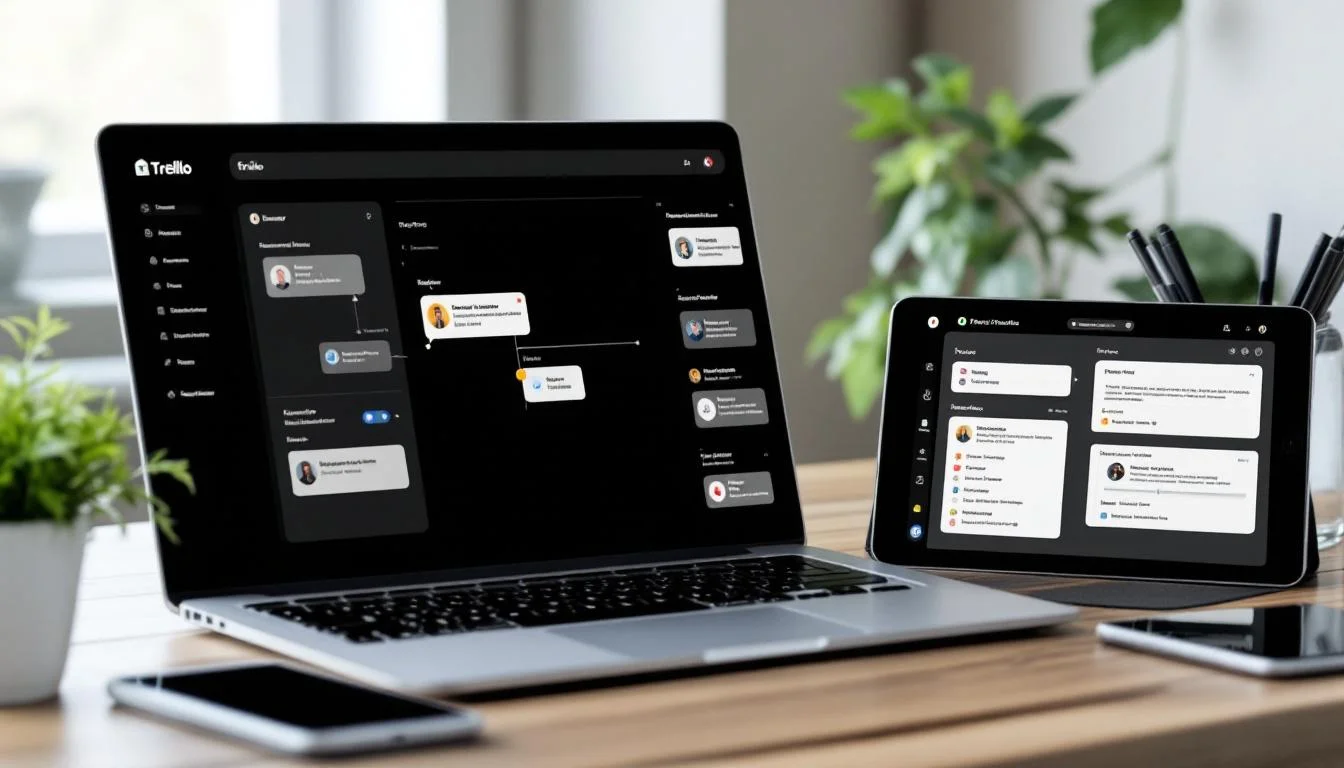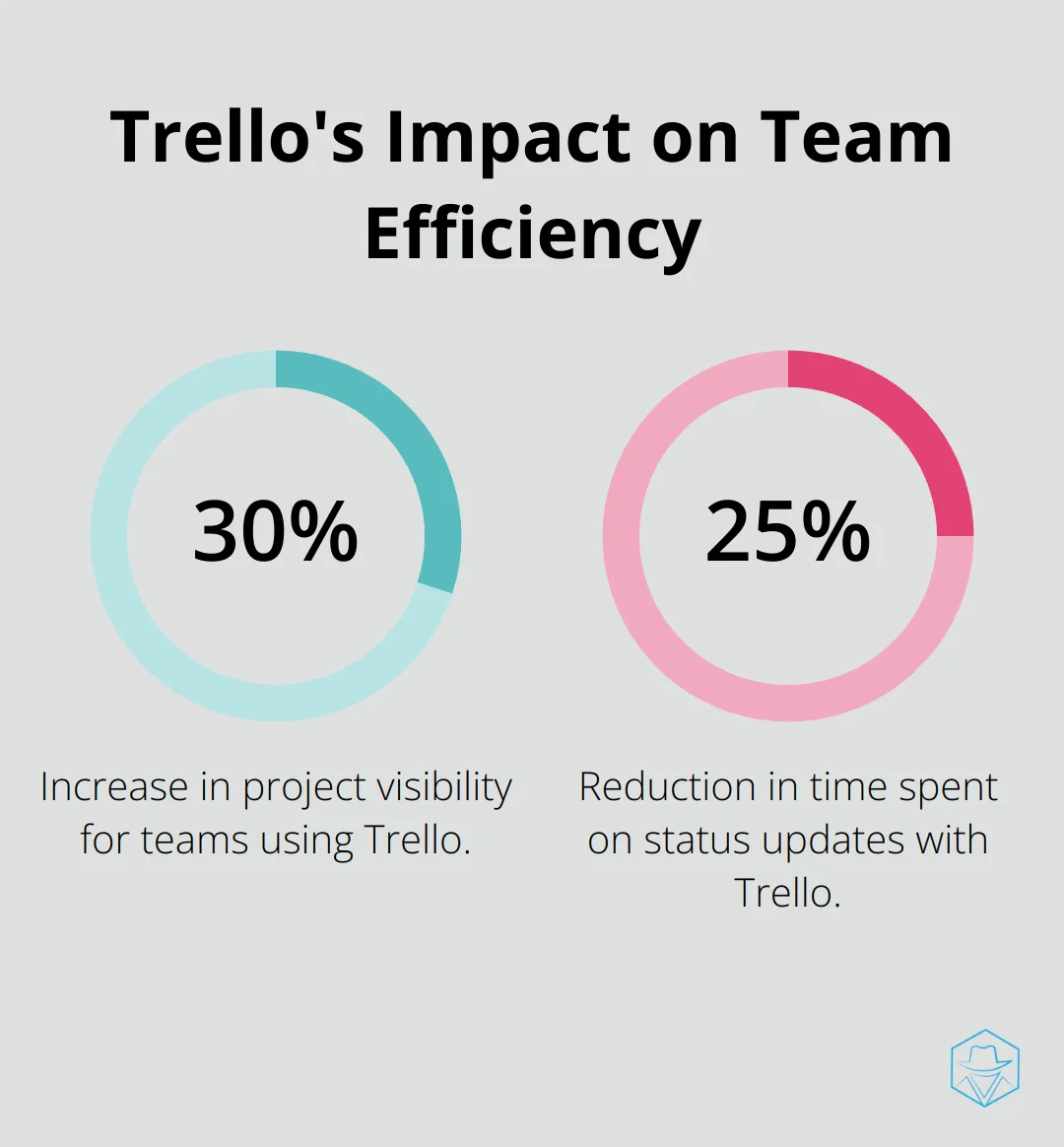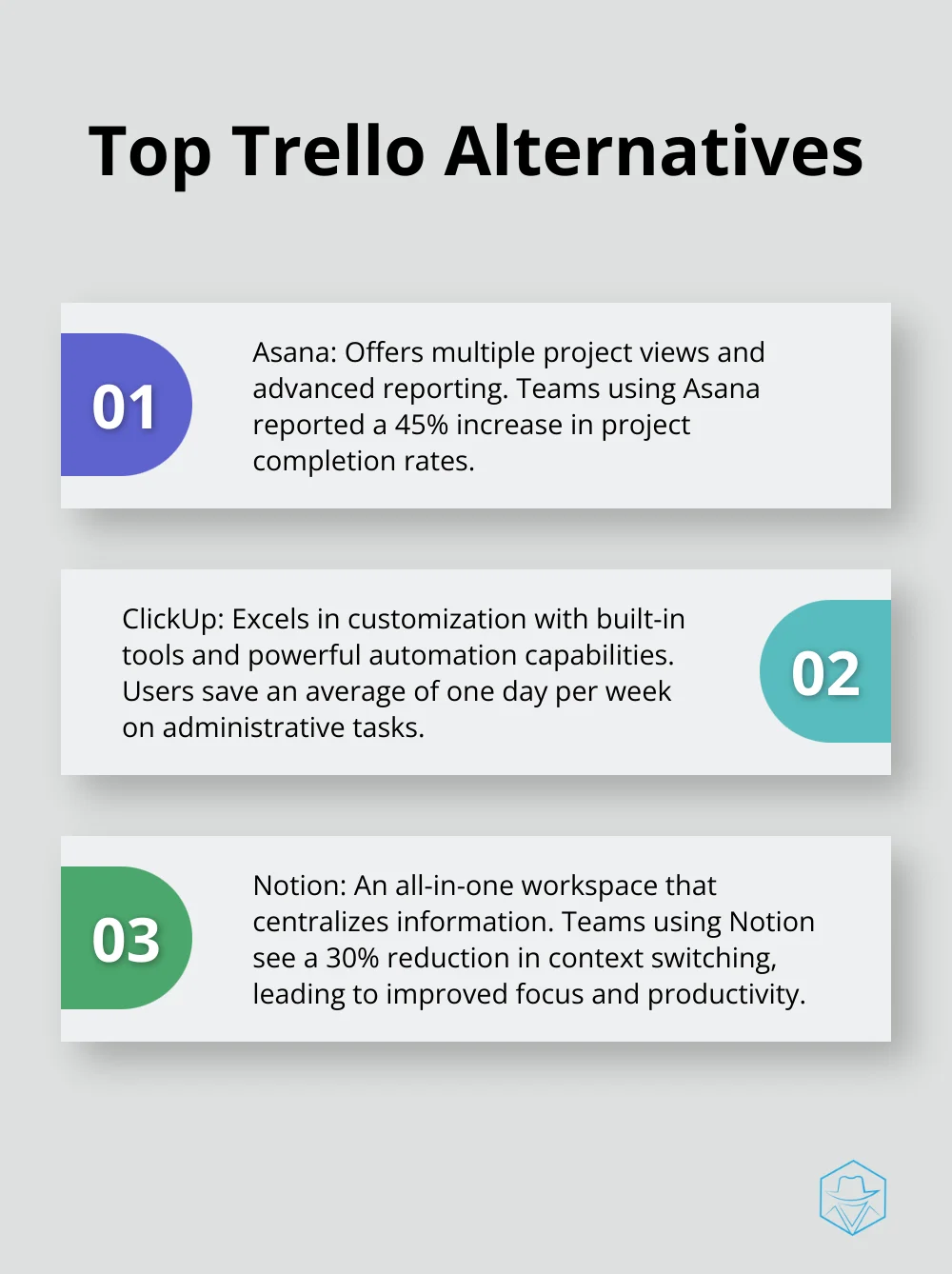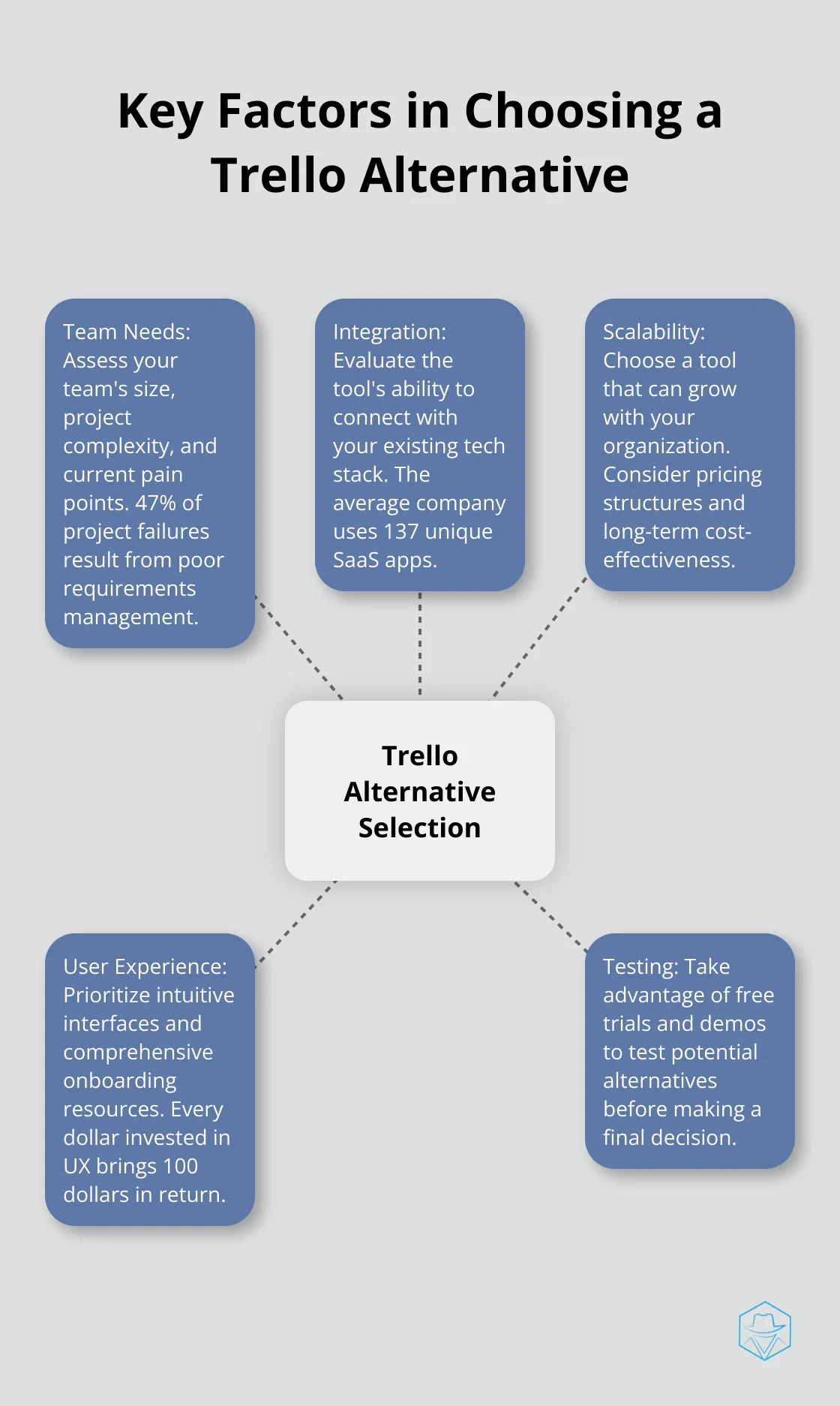How to Find Software Similar to Trello for Your Team

At Drop Cowboy, we understand the importance of finding the right project management tool for your team. Trello has long been a popular choice, but it’s not always the perfect fit for every organization.
In this post, we’ll explore software similar to Trello that might better suit your team’s unique needs. We’ll break down key features to consider and highlight top alternatives to help you make an informed decision.
What Makes Trello Tick?
Trello’s popularity stems from its intuitive design and powerful features. At its core, Trello uses a Kanban-style board system that visually represents tasks as cards. These cards move across different columns, typically representing stages in a workflow.
The Power of Visual Organization
Trello’s visual interface stands out as its key feature. Users quickly grasp project status at a glance, making it easy to identify bottlenecks and track progress. This visual approach proves particularly effective for teams that handle multiple projects simultaneously or those with complex workflows.
Collaboration Made Simple
Trello excels in fostering team collaboration. Users assign tasks, add comments, and attach files directly to cards. This centralized approach to information sharing reduces the need for lengthy email threads or separate communication channels. A study by Atlassian (Trello’s parent company) revealed that teams using Trello reported a 30% increase in project visibility and a 25% reduction in time spent on status updates.

Flexibility Through Integrations
One of Trello’s strengths lies in its extensive integration capabilities. With over 200 Power-Ups available, users connect Trello to popular tools like Slack, Google Drive, and Jira. This flexibility allows teams to customize their workflow and incorporate Trello into their existing tech stack seamlessly.
Limitations of Simplicity
While Trello’s simplicity is a strength, it can also limit more complex project management needs. Trello lacks built-in time tracking and advanced reporting features (which are essential for some teams). This is where alternatives like Drop Cowboy step in, offering more robust features for businesses that need comprehensive project management and communication tools.
As we explore alternatives to Trello, it’s important to consider how these tools address both the strengths and limitations of Trello’s approach. Let’s take a look at some top contenders in the project management space and how they compare to Trello’s feature set.
Top Trello Alternatives for Enhanced Project Management
When it comes to project management tools, Trello isn’t the only option available. Several powerful alternatives offer unique features to boost your team’s productivity. Let’s explore these options and see how they compare to Trello.

Asana: Complex Project Management Made Simple
Asana elevates project management with its robust feature set. Unlike Trello’s board-centric approach, Asana provides multiple views including lists, timelines, and calendars. This flexibility allows teams to visualize projects in ways that best suit their workflow.
Asana’s advanced reporting capabilities stand out. While Trello offers basic progress tracking, Asana delivers detailed insights into team performance and project status. A study by Forrester found that teams using Asana reported a 45% increase in project completion rates.
ClickUp: Customization at Your Fingertips
ClickUp excels in customization. While Trello relies heavily on third-party integrations for advanced features, ClickUp offers a wide array of built-in tools. From time tracking to goal setting, ClickUp provides a comprehensive suite of project management features.
ClickUp’s automation capabilities receive high praise. Users can create custom workflows that automatically assign tasks, send notifications, and update project status. This level of automation saves teams significant time (ClickUp reports that users save an average of one day per week on administrative tasks).
Notion: The All-in-One Workspace
Notion takes a different approach, positioning itself as an all-in-one workspace rather than just a project management tool. While Trello focuses primarily on task management, Notion enables teams to create wikis, databases, and even entire intranets within a single platform.
This versatility makes Notion particularly appealing for teams that want to centralize their information. According to Notion’s user data, teams that switch from using multiple tools to Notion see a 30% reduction in context switching, leading to improved focus and productivity.
Drop Cowboy: Communication-Centric Project Management
While not traditionally categorized as a project management tool, Drop Cowboy offers unique features that complement project workflows. Its ringless voicemail and SMS capabilities (integrated with Mimic AI™) provide powerful communication tools for project teams. This can significantly enhance collaboration and streamline project-related communications.
The choice of project management tool depends on your team’s specific needs and workflow preferences. As we move forward, let’s examine the key factors to consider when selecting a Trello alternative that aligns with your organization’s goals and processes.
How to Choose the Right Trello Alternative
Selecting the perfect Trello alternative for your team requires careful consideration of several key factors. Let’s explore the critical aspects you should evaluate when making your decision.

Assess Your Team’s Unique Needs
Start by conducting a thorough analysis of your team’s specific requirements. Consider the size of your team, the complexity of your projects, and your current pain points with Trello. If you manage a large team across multiple time zones, you might prioritize tools with robust time tracking and reporting features. A survey by Project Management Institute found that 47% of project failures resulted from poor requirements management (highlighting the importance of this step).
Evaluate Integration Capabilities
The ability to integrate with your existing tech stack is important. Look for alternatives that offer seamless connections with the tools your team already uses. For example, if your team heavily relies on Google Workspace, prioritize options that offer native Google integrations. A report by Blissfully states that the average company uses 137 unique SaaS apps (emphasizing the need for strong integration capabilities).
Consider Scalability and Pricing
As your team grows, your project management needs will evolve. Choose a tool that can scale with your organization. Examine pricing structures carefully – some tools charge per user, while others offer flat-rate pricing. ProofHub offers a flat rate of $89/month regardless of team size, which could be more cost-effective for larger teams compared to Trello’s user-based pricing.
Prioritize User Experience
The learning curve associated with new software can significantly impact adoption rates. Look for tools that offer intuitive interfaces and comprehensive onboarding resources. A study by Forrester Research found that every dollar invested in UX brings 100 dollars in return (underscoring the importance of user-friendly design).
Test Drive Potential Alternatives
Take advantage of free trials and demos to test potential alternatives before making a final decision. This hands-on experience will help you determine which tool best fits your team’s workflow and enhances productivity without causing unnecessary disruption. When evaluating features, pricing, and integrations, you’ll be better equipped to find the right fit for your project needs.
Final Thoughts
Our exploration of software similar to Trello reveals numerous alternatives with unique features and capabilities. Asana, ClickUp, Notion, and monday.com each offer robust solutions for complex project management, customizable workflows, and all-in-one workspace needs. Teams must consider factors such as size, project complexity, budget, and integration requirements when evaluating these options.
Drop Cowboy offers unique features that complement project workflows, including ringless voicemail and SMS capabilities powered by Mimic AI™. These tools can streamline project-related communications and enhance team collaboration. The landscape of project management tools continues to evolve, providing diverse options for teams to explore.
Teams should assess their specific needs carefully to find software similar to Trello that meets and exceeds their project management expectations. The right tool can transform how a team collaborates, communicates, and achieves its goals (without causing unnecessary complexity). A thoughtful selection process will lead to improved productivity and smoother project execution.
blog-dropcowboy-com
Related posts

July 20, 2025
How to Implement Marketing Automation Successfully
Boost success with Omnisend eCommerce marketing automation. Explore strategies, practical tips, and insights for seamless implementation.

May 9, 2025
Lead Generation with Marketing Automation
Boost sales and save time with marketing automation for Shopify. Learn proven strategies to enhance lead generation and streamline your processes.

August 22, 2025
Voicemail Marketing Best Practices for High-Growth Businesses
Boost your business growth with effective voicemail marketing tips. Learn strategies to maximize engagement and turn leads into loyal customers.

September 3, 2025
Effective SMS Strategies for Customer Retention and Loyalty
Boost loyalty and retention with effective SMS retention strategies. Learn actionable techniques to keep your customers engaged and satisfied.

May 8, 2025
Inbound Marketing Automation: Attract and Convert
Boost leads with marketing automation for real estate. Attract, engage, and convert prospects effortlessly using effective inbound strategies.

June 16, 2025
Best Phone Dialer Apps for iPhone Users
Discover the top phone dialer apps for iPhone users to enhance call management. Compare features and improve your dialing experience with ease.